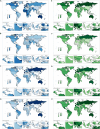Global, regional, and national burden of endocarditis, 1990-2021: a systematic analysis of the GBD 2021 study
- PMID: 40745275
- PMCID: PMC12312326
- DOI: 10.1186/s12872-025-05034-7
Global, regional, and national burden of endocarditis, 1990-2021: a systematic analysis of the GBD 2021 study
Abstract
Background: Endocarditis is a serious cardiovascular infection associated with high mortality and disability. Its global epidemiological patterns and long-term trends have not been comprehensively characterized.
Methods: Data from the Global Burden of Disease (GBD) Study 1990-2021 were used to evaluate the prevalence, incidence, disability-adjusted life years (DALYs), and Deaths of endocarditis across 204 countries and territories. Temporal trends were analyzed using percentage change and estimated annual percentage change (EAPC), stratified by Socio-demographic Index (SDI), region, age, and sex.
Results: Between 1990 and 2021, the absolute number of endocarditis cases increased: prevalence by 14%, incidence by 34%, DALYs by 26%, and Deaths by 29%. Conversely, age-standardized rates declined (EAPCs: -0.58 for prevalence, -0.09 for incidence, -0.33 for DALYs, -0.29 for Deaths). Females had higher prevalence and incidence, while males experienced greater Deaths and DALYs burdens. The burden was concentrated among individuals aged ≥ 65 years, with slight increases observed in children under 5 in low-SDI regions. High-SDI regions showed declining trends in age-standardized metrics, whereas low- and middle-SDI regions exhibited increases. Correlation analysis indicated a moderate association between SDI and prevalence (R = 0.543), a stronger association with incidence (R = 0.770), and a weak correlation with DALYs (R = 0.063).
Conclusions: The absolute burden of endocarditis has increased globally despite declining standardized rates, with older adults and low-SDI populations disproportionately affected. These findings highlight the need for enhanced surveillance and equitable access to care, although limited clinical detail in the GBD framework restricts direct clinical interpretation.
Keywords: DALYs; Disease burden; EAPC; Endocarditis; GBD 2021; SDI.
© 2025. The Author(s).
Conflict of interest statement
Declarations. Ethics approval and consent to participate: Not applicable. Competing interests: The authors declare no competing interests.
Figures





Similar articles
-
Global, regional, and national burden of maternal disorders, 1990-2021: a systematic analysis from the global burden of disease study 2021.BMC Public Health. 2025 Jul 29;25(1):2576. doi: 10.1186/s12889-025-23814-w. BMC Public Health. 2025. PMID: 40730990 Free PMC article.
-
Global, regional, and national burden of endocrine, metabolic, blood, and immune disorders from 1990 to 2021, and projections to 2050: a systematic analysis of the global burden of disease study.Front Endocrinol (Lausanne). 2025 Jul 25;16:1631123. doi: 10.3389/fendo.2025.1631123. eCollection 2025. Front Endocrinol (Lausanne). 2025. PMID: 40786177 Free PMC article.
-
Hepatoblastoma regional trends: dynamic SDI & joinpoint regression analysis.BMC Cancer. 2025 Jul 5;25(1):1148. doi: 10.1186/s12885-025-14566-2. BMC Cancer. 2025. PMID: 40618033 Free PMC article.
-
Global burden and risk factors of musculoskeletal disorders among adolescents and young adults in 204 countries and territories, 1990-2019.Autoimmun Rev. 2023 Aug;22(8):103361. doi: 10.1016/j.autrev.2023.103361. Epub 2023 May 23. Autoimmun Rev. 2023. PMID: 37230312 Review.
-
Burden of inflammatory bowel disease among elderly, 1990-2019: A systematic analysis based on the global burden of disease study 2019.Autoimmun Rev. 2025 Jan 31;24(2):103708. doi: 10.1016/j.autrev.2024.103708. Epub 2024 Nov 23. Autoimmun Rev. 2025. PMID: 39586389
References
-
- Li M, Kim JB, Sastry BKS, Chen M. Infective endocarditis. Lancet. 2024;404(10450):377–92. - PubMed
-
- Cahill TJ, Baddour LM, Habib G, Hoen B, Salaun E, Pettersson GB, Schafers HJ, Prendergast BD. Challenges in infective endocarditis. J Am Coll Cardiol. 2017;69(3):325–44. - PubMed
-
- Mulliken JS, Bainbridge ED. Infective endocarditis. Med Clin North Am. 2025;109(3):667–81. - PubMed
MeSH terms
Grants and funding
LinkOut - more resources
Full Text Sources
Medical

